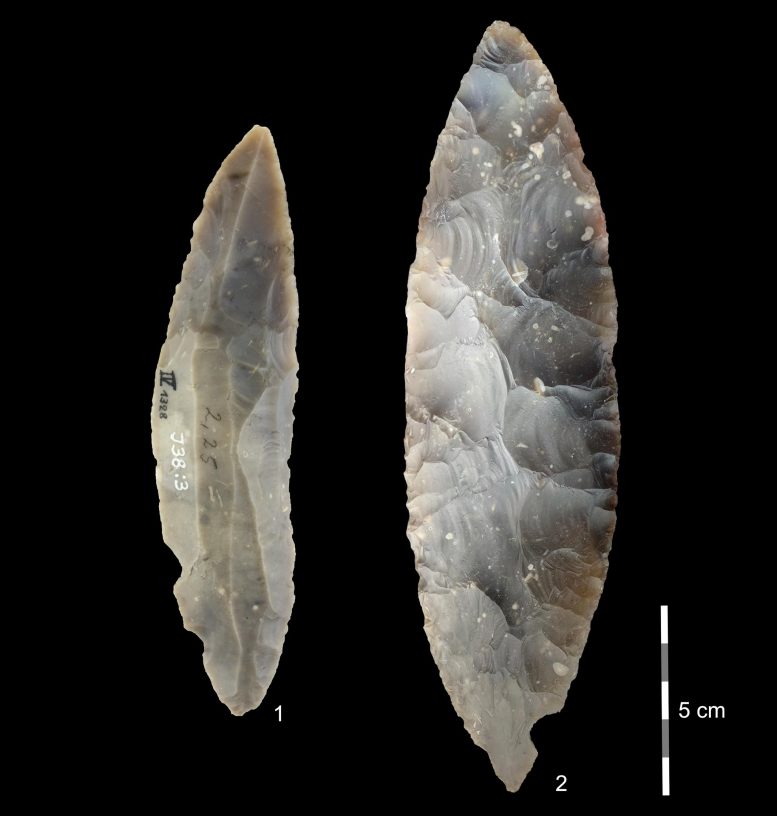
Stone tools from the LRJ at Ranis. 1) partial bifacial blade point characteristic of the LRJ; 2) at Ranis the LRJ also contains finely made bifacial leaf points. Credit: Josephine Schubert, Museum Burg Ranis
The arrival of Homo sapiens in cold northern latitudes took place several thousand years before Neanderthals disappeared in southwest Europe.
The three published studies describe the Homo sapiens fossils from Ilsenhöhle at Ranis and their associated context (Mylopotamitaki et al.), the diet and lifeways of these first pioneers (Smith et al.), and the environmental conditions they faced in Central and NW Europe (Pederzani et al.).
“The Ranis cave site provides evidence for the first dispersal of Homo sapiens across the higher latitudes of Europe. It turns out that stone artifacts that were thought to be produced by Neanderthals were in fact part of the early H. sapiens tool kit. This fundamentally changes our previous knowledge about this time period: H. sapiens reached northwestern Europe long before Neanderthal disappearance in southwestern Europe,” says Jean-Jacques Hublin, Professor at the Collège de France, Paris and emeritus director at the Max Planck Institute for Evolutionary Anthropology in Leipzig, Germany.
Ranis: An 8-Meter Sequence Re-Excavated for the First Time Since the 1930s
An international research team led by Jean-Jacques Hublin (Max Planck Institute for Evolutionary Anthropology and Collège de France, Paris), Shannon McPherron (Max Planck Institute for Evolutionary Anthropology), Tim Schüler (Thüringisches Landesamt für Denkmalpflege und Archäologie) and Marcel Weiss (Friedrich-Alexander-Universität Erlangen-Nürnberg and Max Planck Institute for Evolutionary Anthropology) re-excavated Ranis between 2016 and 2022.
The aims were to locate the remaining deposits from the 1930s excavation, clarify the stratigraphy and chronology of the site, and identify the makers of the LRJ. At the bottom of the 8-meter-deep sequence, the researchers discovered layers containing the LRJ.
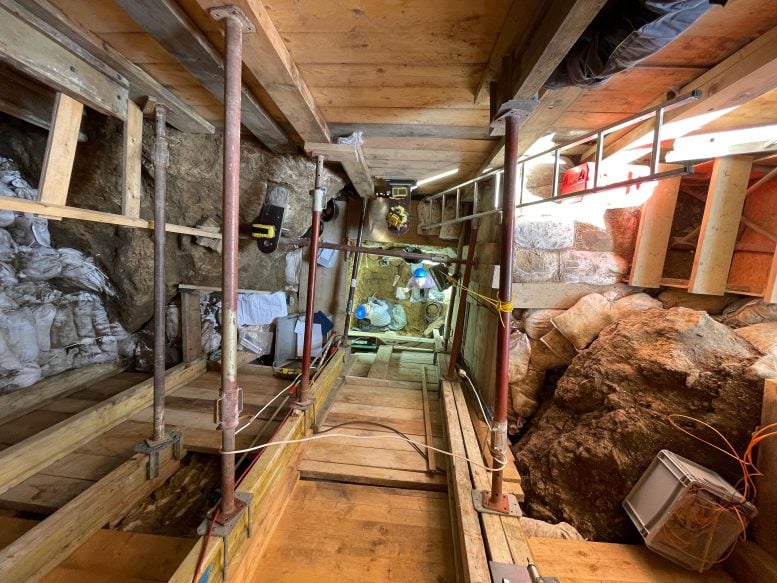
Excavating the LRJ layers 8 meters deep at Ranis was a logistical challenge and required elaborate scaffolding to support the trench. Credit: Marcel Weiss
“The challenge was to excavate the full 8-meter sequence from top to bottom, hoping that some deposits were left from the 1930s excavation. We were fortunate to find a 1.7-meter-thick rock the previous excavators did not get past. After removing that rock by hand, we finally uncovered the LRJ layers and even found human fossils. This came as a huge surprise, as no human fossils were known from the LRJ before, and was a reward for the hard work at the site,” says Marcel Weiss of the Friedrich-Alexander-Universität Erlangen-Nürnberg and the Max Planck Institute for Evolutionary Anthropology.
Thousands of Bone Fragments Revealed Patterns of Site Use and Human Diet
Thousands of highly fragmented pieces of bone were recovered at the site. “Zooarchaeological analysis shows that the Ranis cave was used intermittently by denning hyaenas, hibernating cave bears, and small groups of humans,” explained zooarchaeologist Geoff Smith from the University of Kent and the Max Planck Institute for Evolutionary Anthropology.
“While these humans only used the cave for short periods of time, they consumed meat from a range of animals, including reindeer, woolly rhinoceros, and horses,” said Smith. “Although the bones were broken into smaller pieces, they were exceptionally well preserved and allowed us to apply the latest cutting-edge methods from archaeological science, proteomics, and genetics,” explained Smith.
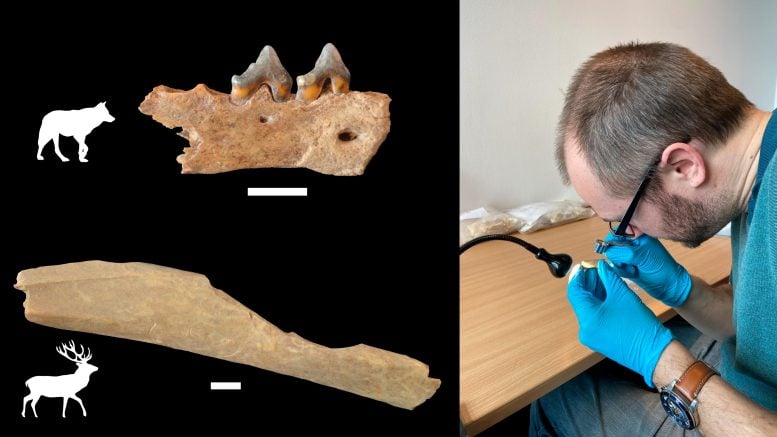
Analysis of over 1000 animal bones from Ranis showed that early Homo sapiens processed the carcasses of deer but also of carnivores, including wolves. Credit: Geoff M. Smith
The First Human Bones From Ranis Were Identified Using Palaeoproteomics
The researchers used the proteins extracted from the morphologically unidentifiable bone fragments to identify the animal and the human remains found in the LRJ layers.
“Palaeoproteomics is a relatively new tool to perform taxonomic identifications of previously unidentifiable skeletal remains recovered from archaeological sites. At Ranis, this enabled us to identify the first human remains associated with the LRJ layers, which were then analyzed further with the latest methods in ancient DNA, radiocarbon dating, and stable isotope analysis,” says Dorothea Mylopotamitaki, a former PUSHH-Marie Sklodowska-Curie Actions Doctoral Fellow at the Collège de France and the Max Planck Institute for Evolutionary Anthropology.

Proteomic extraction from archaeological bone fragments is performed in a sterilized environment to avoid modern contamination. Credit: Dorothea Mylopotamitaki
More H. sapiens Bones Discovered Among Material From the 1930s Excavation
In addition to these new excavations, the team also undertook new analyses of the bone fragments from the old Ranis collection (1932 to 1938 excavations), which are curated and stored at the State Office for Heritage Management and Archaeology Saxony-Anhalt in Germany. This included a study where the bones were examined one by one to potentially identify human remains.
“This painstaking work was rewarded by the discovery of several new human bones,” said Hélène Rougier, a palaeoanthropologist at California State University Northridge. “Finding human remains mixed with animal bones that had been stored for almost a century was an unexpected and fantastic surprise,” she added.
Further work on these collections is ongoing by Hélène Rougier and researchers from the State Office for Heritage Management and Archaeology Saxony-Anhalt and highlights the enormous value of museum collections.
DNA Sequencing Showed That the Bones Were Homo sapiens
Once the 13 human skeletal remains from both the old and new excavations were identified, DNA was extracted from these fossils and analyzed.
“We confirmed that the skeletal fragments belonged to Homo sapiens. Interestingly, several fragments shared the same mitochondrial DNA sequences – even fragments from different excavations. This indicates that the fragments belonged to the same individual or were maternal relatives, linking these new finds with the ones from decades ago,” says Elena Zavala, a Miller Postdoctoral Research Fellow at the University of California, Berkeley, and Max Planck Institute for Evolutionary Anthropology.
Another important goal was to obtain DNA from the sediments at the site, especially from the LRJ layers. Therefore, in addition to their search for human bone fragments, the team also extracted ancient mammalian DNA from sediment samples to complete the zooarchaeological analysis. Additionally, nuclear DNA analyses are ongoing in collaboration with Arev Sümer at the Max Planck Institute for Evolutionary Anthropology.

After chemical preparation and purification, very small samples from animal teeth are loaded into the magazine of an isotope ratio mass spectrometer to obtain oxygen stable isotope ratios, which yield information about past climates that animals lived in. Credit: Max Planck Institute for Evolutionary Anthropology
Homo sapiens Reached Northwest Europe As Early as 47,500 Years Ago
Radiocarbon dating was used to understand when humans occupied the cave. Homo sapiens bones from both the 1930s and 2016 to 2022 excavations were directly dated using very small amounts of bone to preserve the material for further analyses. The dates show that these individuals were some of the earliest Homo sapiens to inhabit Europe. The team also carried out radiocarbon dating of animal bones from different layers of the site to reconstruct the site’s chronology. They focused on bones with traces of human modifications on their surfaces, linking the dates to human presence at the cave. “We found very good agreement between the radiocarbon dates from the Homo sapiens bones from both excavation collections and with modified animal bones from the LRJ layers of the new excavation, making a very strong link between the human remains and LRJ. The evidence suggests that Homo sapiens were sporadically occupying the site from as early as 47,500 years ago,” says Helen Fewlass, an EMBO Postdoctoral Fellow at the Francis Crick Institute, London, and formerly of the Max Planck Institute for Evolutionary Anthropology.
Homo sapiens Had the Capacity To Adapt to Harsh, Cold Climatic Conditions
Stable isotope analyses on animal teeth and bones allow insights into the climatic conditions and environments that the pioneering groups of Homo sapiens encountered around Ranis. The team combined information from a broad range of different stable isotope ratios and was able to show that a very cold continental climate and open steppe landscapes, similar to those found in Siberia or northern Scandinavia today, prevailed during the time of the LRJ, and climatic conditions cooled even further throughout the LRJ occupations of Ranis.
“This shows that even these earlier groups of Homo sapiens dispersing across Eurasia already had some capacity to adapt to such harsh climatic conditions,” says Sarah Pederzani from the University of La Laguna and the Max Planck Institute for Evolutionary Anthropology, who led the palaeoclimate study of the site.
“Until recently it was thought that resilience to cold-climate conditions did not appear until several thousand years later, so this is a fascinating and surprising result. Perhaps cold steppes with larger herds of prey animals were more attractive environments for these human groups than previously appreciated.”
Milestone Study on the Initial Incursions of Homo sapiens Into Europe
This comprehensive study, integrating archaeological excavation, morphological and proteomic taxonomic identification, mitochondrial DNA analysis, radiocarbon dating of newly excavated archaeological material and of human remains, zooarchaeology, and isotope analysis marks a significant milestone in understanding the initial incursions of Homo sapiens into Europe north of the Alps during the Middle to Upper Palaeolithic transition.
Furthermore, the team found that Homo sapiens ventured into Europe under severe cold climatic conditions. Moving in small groups, they shared their environment and sites with large carnivores, like hyenas, and they manufactured elaborately crafted leaf-shaped stone tools.
“The results from the Ilsenhöhle in Ranis fundamentally change our ideas about the chronology and settlement history of Europe north of the Alps. It is especially exciting that we now have the oldest H. sapiens here in Thuringia, Germany,” says Tim Schüler of the Thüringisches Landesamt für Denkmalpflege und Archäologie.
Reference: “Homo sapiens reached the higher latitudes of Europe by 45,000 years ago” by Dorothea Mylopotamitaki, Marcel Weiss, Helen Fewlass, Elena Irene Zavala, Hélène Rougier, Arev Pelin Sümer, Mateja Hajdinjak, Geoff M. Smith, Karen Ruebens, Virginie Sinet-Mathiot, Sarah Pederzani, Elena Essel, Florian S. Harking, Huan Xia, Jakob Hansen, André Kirchner, Tobias Lauer, Mareike Stahlschmidt, Michael Hein, Sahra Talamo, Lukas Wacker, Harald Meller, Holger Dietl, Jörg Orschiedt, Jesper V. Olsen, Hugo Zeberg, Kay Prüfer, Johannes Krause, Matthias Meyer, Frido Welker, Shannon P. McPherron, Tim Schüler and Jean-Jacques Hublin, 31 January 2024, Nature.
DOI: 10.1038/s41586-023-06923-7

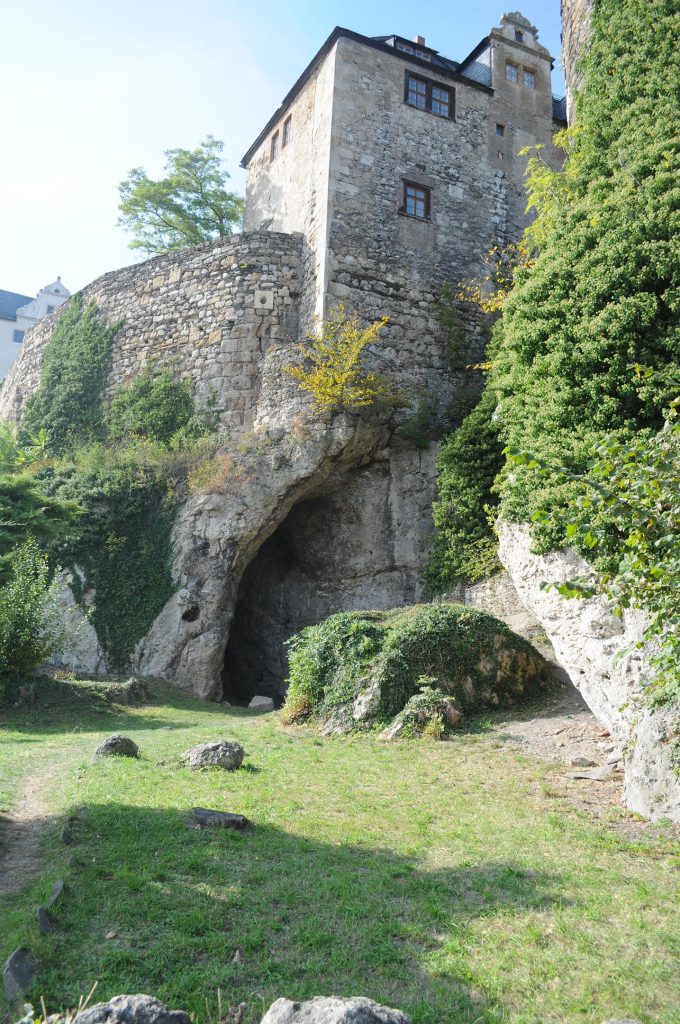
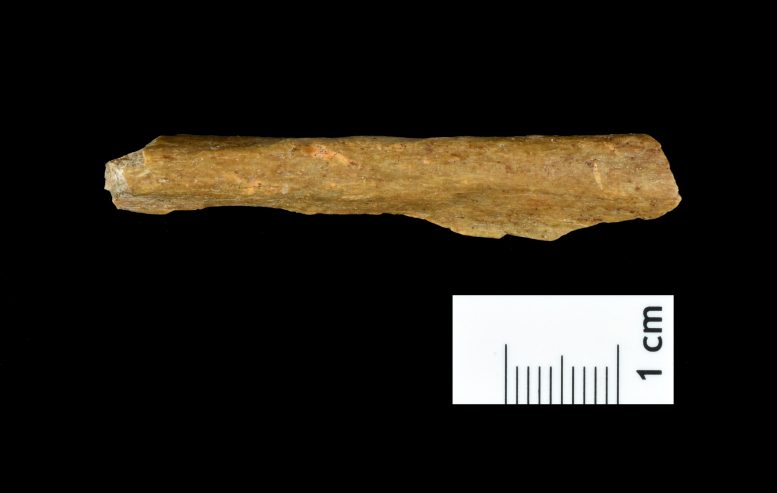

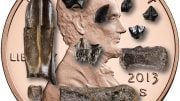


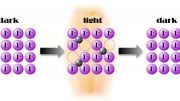



Lincombian-Ranisian-Jerzmanowician (LRJ). Should have been defined and explained in the article rather than just the use of the initials LRJ.